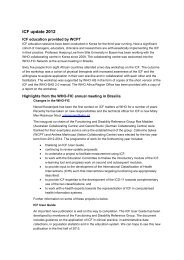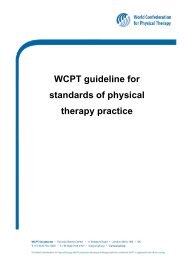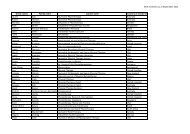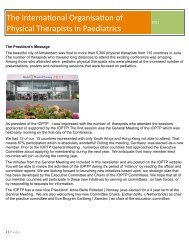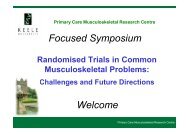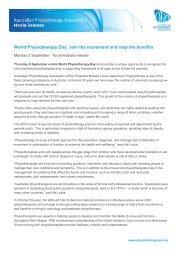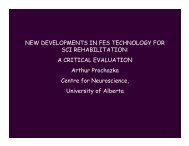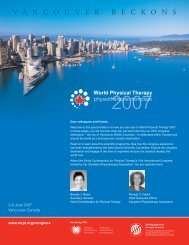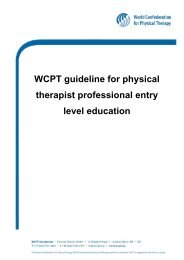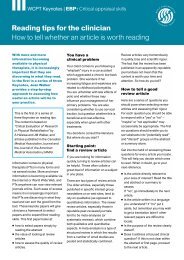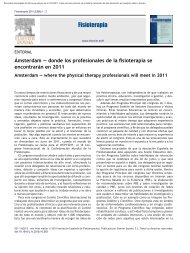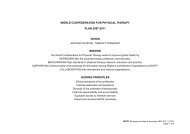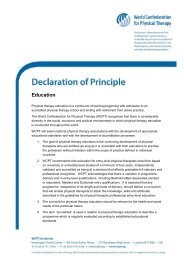wcpt congress: event of a lifetime - World Confederation for Physical ...
wcpt congress: event of a lifetime - World Confederation for Physical ...
wcpt congress: event of a lifetime - World Confederation for Physical ...
Create successful ePaper yourself
Turn your PDF publications into a flip-book with our unique Google optimized e-Paper software.
RESEARCH<br />
THE LATEST RESEARCH,<br />
REVIEWS AND REFERENCES<br />
JANET COPELAND<br />
POLICY & RESEARCH ADVISOR<br />
PHYSIOTHERAPY NEW ZEALAND<br />
Osteoarthritis<br />
The Ottawa panel consists<br />
<strong>of</strong> a group <strong>of</strong> health pr<strong>of</strong>essionals<br />
based in Canada.<br />
In 2005 they published<br />
guidelines on physiotherapy<br />
management <strong>for</strong> osteoarthritis<br />
(OA).<br />
Recently they have published a new<br />
guideline specifically focusing on the<br />
needs <strong>of</strong> people with OA who are<br />
obese/overweight. The guideline focuses<br />
on the complex issues they <strong>of</strong>ten<br />
present with (Ottawa Panel, 2011).<br />
The guideline was based on a literature<br />
review conducted using the Cochrane<br />
Collaboration search techniques. 114<br />
articles were found but only 10 meet<br />
the rigorous inclusion criteria.<br />
An overriding finding was that a<br />
physical activity programme combined<br />
with dietary advice produced greater<br />
benefits <strong>for</strong> pain relief and improved<br />
functional status than either intervention<br />
alone. This has implications <strong>for</strong><br />
physiotherapy practice and supports<br />
the move from physiotherapists working<br />
in isolation to working as part <strong>of</strong> a<br />
healthcare team.<br />
The study also found the interventions<br />
produced significant improvements in<br />
quality <strong>of</strong> life. This was thought to be<br />
due to the beneficial effects on mental<br />
health <strong>of</strong> participating in physical<br />
activity, including <strong>for</strong> many the<br />
social contact involved. The physical<br />
activity programmes included a combination<br />
<strong>of</strong> aerobic, strength and<br />
resistance training.<br />
Although this article is not yet open<br />
access the earlier guidelines are:<br />
(Ottawa Panel, 2005) http://ptjournal.<br />
apta.org/content/85/9/907.full.pdf+html<br />
To coincide with our promotion <strong>of</strong><br />
the role <strong>of</strong> physiotherapy in the treatment<br />
<strong>of</strong> arthritis, towards the end <strong>of</strong><br />
August we will put onto our website<br />
resources including articles supporting<br />
the efficacy <strong>of</strong> our interventions. Also<br />
remember to check out some <strong>of</strong> the<br />
latest research on arthritis using the<br />
EBSCO database. Access to EBSCO<br />
can be gained from a button on our<br />
website home page.<br />
Lymphoedema<br />
The provision <strong>of</strong> lymphoedema services<br />
in New Zealand is rather haphazard,<br />
with services being organised through<br />
the Cancer Society in discussion with<br />
individual DHBs. An article in the BMJ<br />
(Girgis, Stacey, Lee, Black, & Kilbreath,<br />
2011) would suggest the same<br />
problems occur in Australia.<br />
Women who were identified as having<br />
lymphoedema were asked to identify<br />
their current unmet needs. The main<br />
needs identified by participants were<br />
improved access to consistent in<strong>for</strong>mation<br />
on the causes <strong>of</strong> lymphoedema,<br />
the treatment options and then how<br />
to access treatment. The women<br />
felt there was a need <strong>for</strong> all health<br />
pr<strong>of</strong>essionals to take their condition<br />
seriously and to be fully in<strong>for</strong>med so<br />
they could provide the women with<br />
the necessary in<strong>for</strong>mation.<br />
This article is open access:<br />
http://www.bmj.com/content/342/<br />
bmj.d3442.full.pdf<br />
Prescribing Exercise<br />
An editorial in the BMJ (Khan, Weiler,<br />
& Blair, 2011) discusses the value<br />
<strong>of</strong> exercise in the pr<strong>event</strong>ion and<br />
treatment <strong>of</strong> many <strong>of</strong> the chronic<br />
diseases that have become the leading<br />
causes <strong>of</strong> morbidity and mortality<br />
in the 21st century. The article is<br />
directed to doctors, suggesting that at<br />
each consultation they ask questions<br />
regarding the patient’s activity levels,<br />
and stating that activity levels have<br />
become the 5th vital sign (the other<br />
four are temperature, pulse, blood<br />
pressure and respiratory rate). They<br />
suggest 2 activity screening tools that<br />
can easily be implemented in general<br />
practice: the General Practice <strong>Physical</strong><br />
Activity Questionnaire (GPPAQ), and<br />
the Exercise Vital Signs questions (Sallis,<br />
2011). In<strong>for</strong>mation on both <strong>of</strong> these is<br />
easy to Google.<br />
We are well placed to ask our<br />
patients about their activity<br />
levels as part <strong>of</strong> a routine<br />
assessment and provide them<br />
with advice.<br />
Although doctors were the authors’<br />
prime audience, the article makes<br />
equal sense to physiotherapy. We are<br />
well placed to ask our patients about<br />
their activity levels as part <strong>of</strong> a routine<br />
assessment and provide them with advice.<br />
For some this may include further<br />
physiotherapy assessment and a structured<br />
exercise programme to get them<br />
started; <strong>for</strong> others encouragement and<br />
providing in<strong>for</strong>mation about community<br />
resources and facilities may be<br />
sufficient. Many <strong>of</strong> these are low cost,<br />
and walking is free. It is useful to have<br />
available in the practice in<strong>for</strong>mation<br />
on community resources. Whatever<br />
approach is taken, it is important to follow<br />
up with the patient at subsequent<br />
visits. One <strong>of</strong> the authors (Sallis) based<br />
12 | PHYSIO MATTERS AUGUST 2011



